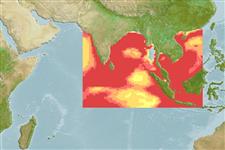Common names from other countries
Environment: milieu / climate zone / depth range / distribution range
экология
морской; солоноватоводный; мигрирует в океане (Ref. 51243); пределы глубины 0 - 50 m (Ref. 189). Tropical; 25°N - 9°S, 69°E - 117°E (Ref. 189)
Indo-West Pacific: western coast of India to Myanmar and south to Java, Indonesia.
Length at first maturity / Size / Вес / Возраст
Maturity: Lm 13.0 range ? - ? cm
Max length : 19.0 cm TL самец/пол неопределен; (Ref. 55634); 20.5 cm TL (female); наибольший вес (опубликованные данные): 60.70 g (Ref. 55634); наибольший вес (опубликованные данные): 60.70 g
колючие лучи спинного плавника (общее число) : 0; колючие лучи анального плавника: 0; членистые (мягкие) лучи анального плавника: 29 - 37. Belly with 24 to 32 keeled scutes from isthmus to anus. Tip of snout on a level with eye center. Maxilla long, reaching to or almost to base of first pectoral fin ray; first supra-maxilla oval, minute. Lower gill rakers with serrae on the inner edge even and not clumped. A dark blotch behind upper part of gill opening.
Found in coastal pelagic waters and often observed as entering mangroves and adjacent brackish waters (Ref. 43081). Juveniles and adults may penetrate the upper reaches where mixohaline-mesohaline conditions prevail. Eggs and larvae are found in the lower reaches of the mangroves (Ref. 43081). A schooling species found mostly inshore. Feed on planktonic organisms in coastal waters (Ref. 43081). Juveniles in mangroves feed on larvae of shrimps and fish (Ref. 43081). Confusions in identification make all previous biological studies unreliable. One of the commonest species of Thryssa (if identifications have been correct).
Wongratana, T., T.A. Munroe and M. Nizinski, 1999. Order Clupeiformes. Engraulidae. Anchovies. p. 1698-1753. In K.E. Carpenter and V.H. Niem (eds.) FAO species identification guide for fishery purposes. The living marine resources of the WCP. Vol. 3. Batoid fishes, chimaeras and bony fishes part 1 (Elopidae to Linophrynidae). FAO, Rome. (Ref. 9822)
Статус Красного Списка МСОП (Ref. 130435)
CITES (Ref. 128078)
Not Evaluated
Угроза для людей
Harmless
Использование человеком
рыболовство: коммерческий
дополнительная информация
инструменты
Специальные отчеты
Скачать в формате XML
ресурсы в Интернет
Estimates based on models
Preferred temperature (Ref.
115969): 26.8 - 29.2, mean 28.6 (based on 648 cells).
Phylogenetic diversity index (Ref.
82804): PD
50 = 0.5000 [Uniqueness, from 0.5 = low to 2.0 = high].
Bayesian length-weight: a=0.00603 (0.00375 - 0.00968), b=3.02 (2.89 - 3.15), in cm Total Length, based on LWR estimates for this species & (Sub)family-body (Ref.
93245).
Trophic level (Ref.
69278): 3.6 ±0.6 se; based on diet studies.
устойчивость к внешним воздействиям (Ref.
120179): высокий, минимальное время удвоения популяции до 15 месяцев (K=0.76).
Fishing Vulnerability (Ref.
59153): Low vulnerability (18 of 100).
